Editor’s Note: As of publication date, the Philippine destinations included in this article are only open to local travellers. This disclaimer will be removed once the Philippines opens its borders to international travellers.
Deep in the Southeast Asian tropics where travellers often seek sun-kissed getaways on dreamy shores, treasure grows on fertile soil. This earthly magic is something that visitors may easily witness by touring the best farms in the Philippines!
LATEST PHILIPPINE TRAVEL UPDATES
The treasures we speak of are the luxuriant sort, of course. They’ve been rooting themselves on this verdant archipelago long before the advent of farm tourism in the Philippines. After all, the country is highly agricultural; almost every meal on any of its 7,000+ islands is accompanied by a filling cup (or cups!) of rice. Here, crops (and cropland) are held in high regard.
It isn’t difficult to imagine then that Philippine farms boast bountiful harvests and the perfect gateways for a different kind of nature escape! Visit a farm and you help out an industrious farmer; visit a farm and you actually help yourself recover from stress and anxiety brought about by the COVID-19 pandemic. Don’t believe us? Read on to know more about farm tourism, agriculture in the Philippines, and how visiting local farms boosts recovery post-lockdown.
Why should you support farm tourism?
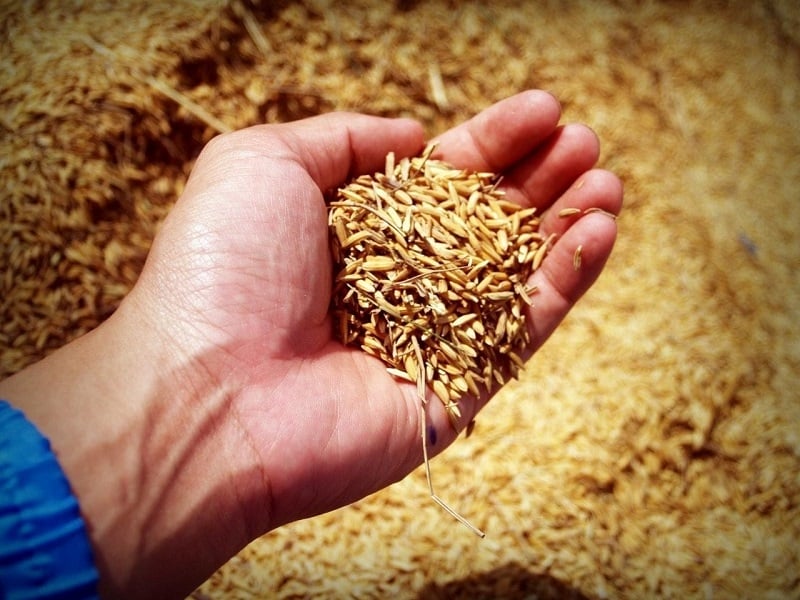
“Shake the hand that feeds you”
Before we begin our agri-adventure, here’s something to chew on: Have you eaten today? If your answer is yes, then congratulations, you just had indirect interaction with a farmer! Everything from grains to vegetables and even your favourite melt-in-your-mouth meat was likely grown on a farm.
So when you visit any farm in any part of the globe, you get to know the people who nourish you with the food they grow. As Philippines-Department of Tourism (DOT) Secretary Berna Romulo-Puyat once said, “Shake the hand that feeds you”. We’ll have to do that figuratively now since contactless conversations are a must, but isn’t that a lovely notion?
Nature nurtures
Another reason to visit farms in the Philippines? It’s good for your health in more ways than you think. Sure, farms grow produce and livestock that keep you fuelled, but did you know that merely touring one positively affects your well-being? Many studies support this, and it circles back to one fun fact: Nature heals and nurtures.
Exposure to the great, lush outdoors lifts your mood and allows you to breathe in the freshest air. The Japanese observe shinrin-yoku or forest bathing; it’s a form of therapy that lets you reconnect with the natural world, all while boosting your immunity and combating stress. Research says that the colour green calms and refreshes you to the point of improving focus and reading comprehension. If there’s one thing you’ll see a lot of in farmland no matter the terrain, it’s every shade of green imaginable!
We could go on, really, but the point is, to set foot on a farm is to run into nature’s open arms. And boy, we could really use a hug from Mother Earth after all that physical distancing!
PHILIPPINE TRAVEL ADVISORIES HERE
Farms in the Philippines — why they’re more fun
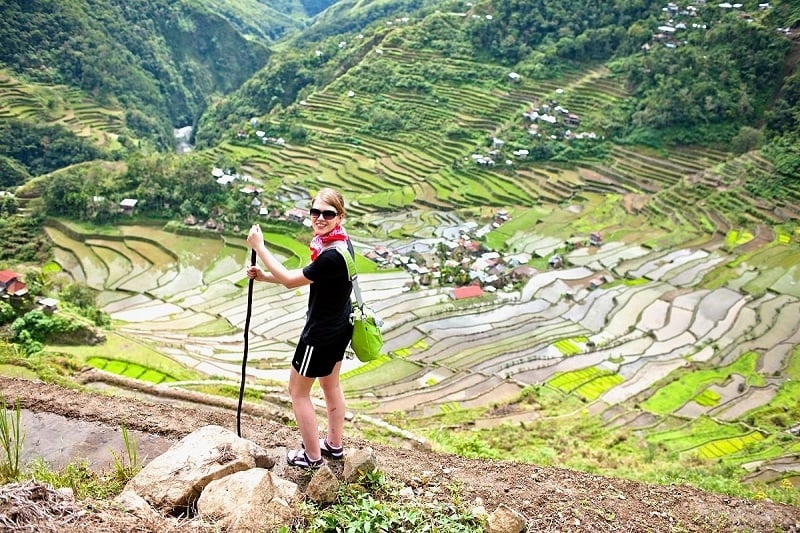
Image credit: Beyond Neon
Meet Filipino farmers
Agriculture in the Philippines is representative of so many things the country is known for. Visiting local farms gives tourists a peek into the distinct Filipino culture of resilience and hospitality. When you take part in farm tourism, you step into a farmer’s home and wear his or her shoes for a day. The experience is truly immersive and insightful, plus you get to support farmers trying to earn a living outside of harvest seasons. Moreover, visiting Philippine farms when borders open again helps farmers recover from the losses they incurred during the pandemic’s lockdown and quarantine periods.
Also read: Slowly But Surely: Here’s What Tourism Reopening Looks Like in The Philippines
Philippine farms are accredited to give you the best experiences
Tourists are assured that farms in the Philippines are safe and secure for leisure activities. They also adhere to strict COVID-19 health protocols. Here are some you can be sure to expect:
- Stringent social distancing
- Mask- and face shield-wearing
- Reduced carrying capacity
- Personal health declaration for effective contact tracing
- Regular disinfection at entry and exit points
LEARN MORE ABOUT COVID-19 SAFETY PROTOCOLS
On top of this, you’ll get to benefit from fresh air and sample local delicacies (yes, native crops and tropical fruits included!). Take the chance to interact with friendly locals to boot, minus the crowd, because you’ll have all the open space you need to keep your distance.
Travel tip: Keep in mind that the Philippines has only reopened select tourism destinations to local tourists; check updates and the official list of reopened tourism sites here. Before planning a trip to any Philippine farm, be sure to confirm if the farm establishment is authorised to accept visitors in the new normal. Of course, farms in the Philippines are covered by the COVID-19 regulations implemented by their respective local and provincial government units.
Support eco-friendly tours
Farm-to-table movements and farm tourism destinations also support pro-environment causes. With every visit to a Philippine farm, you help uphold sustainable, agriculture-based tourism.
Support farm tourism in the Philippines, and you actually do more than just visit a farm. You help Filipino farmers; you protect the environment; you boost post-lockdown recovery; and you fulfil your tropical #travelgoals with the most breathtaking landscapes.
We know that this will all have to wait, though, for when the Philippines finally welcomes back international travellers. Local travellers can check here to know which domestic destinations have already reopened for tourism. In the meantime, here’s a “virtual tour” of the best farms in the Philippines. They’re all perfect for idyllic getaways post-pandemic — and you can certainly squeeze them in your future itineraries!
Top farm tourism destinations in the Philippines
1. Lao Integrated Farm
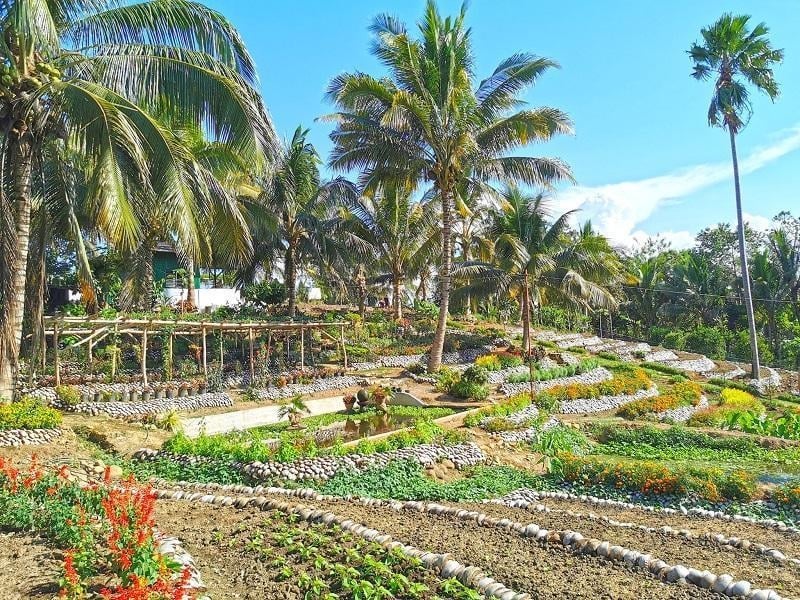
A trip to Lao Integrated Farm in Davao del Sur is rejuvenating yet instructional! | Image credit: Lao Integrated Farm Official Facebook Page
Visiting organic farms in the Philippines is good for you, too. Why? The folks at Lao Integrated Farm keep it short and sweet: “Life’s Amazing with Organics!” We can’t help but agree. Lao Integrated Farm is a model eco-tourism site that educates guests about organic farming, farm tourism, Sloping Agricultural Land Technology, and Upland Micro-catchment Technology.
If you’re lucky, you might even meet Lao Integrated Farm’s founder, a brilliant Magsasaka Siyentista or farmer scientist recognised by the Philippine Council for Agriculture, Aquatic and Natural Resources Research and Development.
Address: Purok 4, Bgy. Eman, Davao-Cotabato Road, Bansalan, Davao del Sur
Visiting hours: Monday to Friday 8am to 3pm, Saturday 8am to 2pm
Contact: Lao Integrated Farm official website
Travel time from Manila: Board a two-hour flight from Manila to Davao. From downtown Davao city, it takes around one hour and 45 minutes to drive to Lao Integrated Farm.
How Davao safeguards your health: Aside from the usual accommodations and F&B COVID-19 protocols, Davao boasts of brand-new RT-PCR machines and RNA extractors for a COVID-19 testing laboratory right at tourists’ main port of entry, Francisco Bangoy International Airport (Davao International Airport).
2. The Weekend Farmer
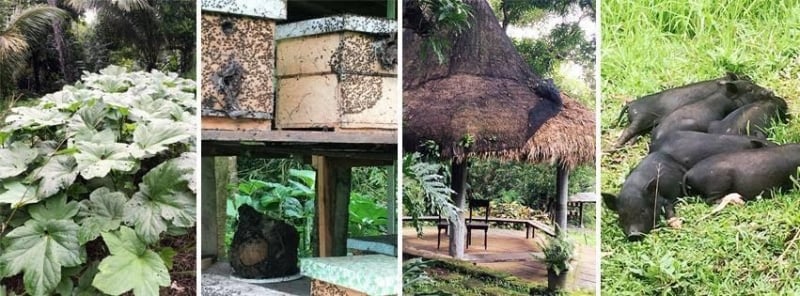
Looking for a farm in the Philippines with nice accommodations? The Weekend Farmer won’t disappoint with rooms that can host two to six guests! | Image credit: The Weekend Farmer Official Facebook Page
For travel-hungry weekend warriors, Saturdays and Sundays are spent crossing borders for exploration. The Weekend Farmer, an Airbnb superhost and farm tourism site nestled in the highlands of Cavite, believes in dedicating days off to reconnecting with the natural world. Aside from tours, this Philippine farm also conducts workshops on traditional medicine, growing your own food, and processing produce in more sustainable ways. Just goes to show how agriculture in the Philippines also intersects with the health and wellness industries.
Address: Kaysuyo Road, Kaytitinga, Alfonso, Cavite
Visiting hours: Wednesday to Sunday 9am to 6pm
Contact: The Weekend Farmer official website
Travel time from Manila: It takes anywhere from two to three hours to drive to The Weekend Farmer from Manila, depending on traffic.
3. Nurture Farmacy
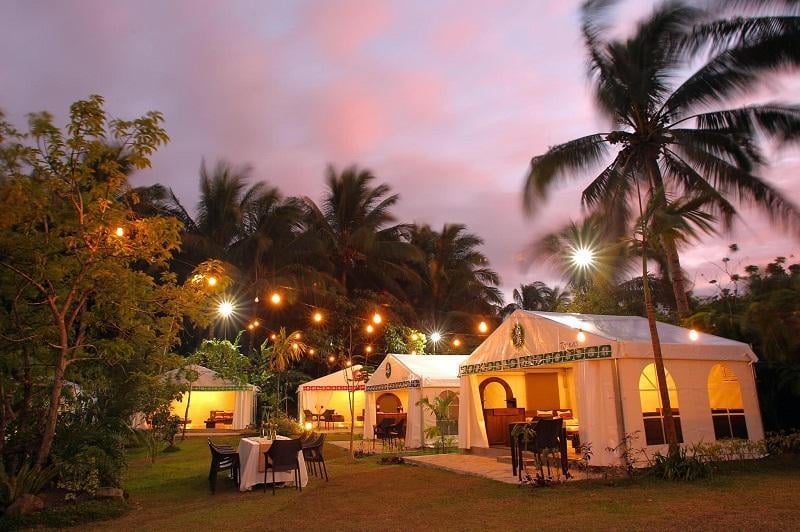
While Nurture Wellness Village offers hotel accommodations, Nurture Farmacy gives you the chance to try out glamping at the farm. | Image credit: Nurture Farmacy Official Facebook Page
Nurture Farmacy is quite unlike most Philippine farms. Interestingly enough, this Cavite property spans a city and a municipality because it sits right on the border between Tagaytay and Amadeo. Nurture Farmacy is also an offshoot of Nurture Wellness Village, a spa resort and retreat that spotlights traditional Filipino healing. To enter the farm, you must go through the wellness centre — which is quite the treat! Don’t worry; once you’re inside Nurture Wellness Village, Nurture Farmacy will just be a leisurely stroll away.
Address: Amadeo, Cavite (enter the farm through Nurture Wellness Village Pulong Sagingan, Barangay Maitim II West, Tagaytay, Cavite)
Visiting hours: 9am to 5pm
Contact: Nurture Wellness Village official website
Travel time from Manila: It takes about an hour and 40 minutes to drive to Nurture Farmacy from Manila.
4. Rapha Valley
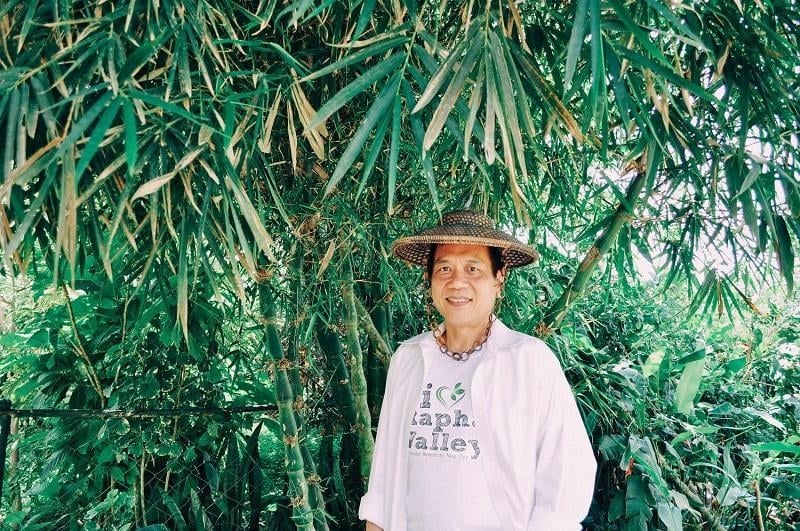
Rapha Valley founder Dr. Albery Jo all smiles at the farm. | Image credit: Rapha Valley Official Website
At Rapha Valley, food is medicine. That said, they respect the land that sustains, nurtures, and cures us — something all guests learn in just one visit. Explore Rapha Valley’s farm grounds and understand how organic farming plays a big role in wellness that lasts. Sign up for a farm tour with Rapha Valley founder Dr. Albert Jo! He readily shares extensive knowledge on plant-based health practices and functional nutrition.
Address: Km.48 Brgy. Kumaliskis, Don Salvador Benedicto, Negros Occidental
Visiting hours: Monday to Thursday by reservation, Friday to Sunday 8am to 5pm
Contact: Rapha Valley official Facebook page
Travel time from Manila: Board a flight from Manila to Bacolod in Negros Occidental. This lasts about one hour and 20 minutes. From Bacolod, it takes around the same time to drive to Rapha Valley.
LATEST PHILIPPINE TRAVEL UPDATES
5. Alomah’s Place and Nature Farm
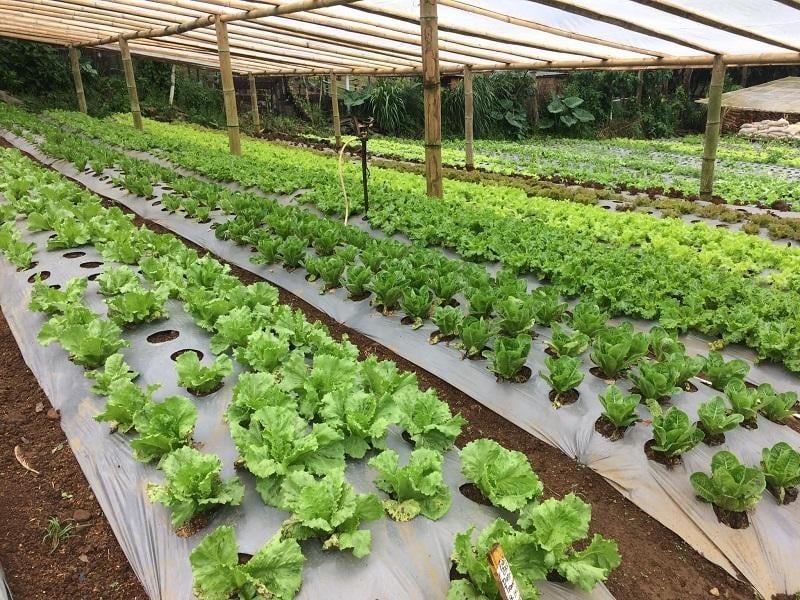
Can you imagine getting to do this in your own backyard? Learn how at Alomah’s Place and Nature Farm. | Image credit: Alomah’s Place and Nature Farm Official Facebook Page
Not only is Alomah’s Place and Nature Farm a campsite and an award-winning farm tourism destination; it’s also a place literally built on the principles of reusing, reducing, and recycling. This farm in the Philippines is peppered with repurposed scrap materials turned into decor or used as farming paraphernalia. Here, you can learn about the basics of backyard gardening and vermicomposting, or be inspired by the success story of the couple behind the farm.
Address: Brgy. Dahilayan, Manolo Fortich, Bukidnon
Visiting hours: By reservation
Contact: Alomah’s Place and Nature Farm official Facebook page
Travel time from Manila: Board a flight from Manila to Cagayan de Oro. This takes around an hour and 30 minutes. It will take you another two hours to drive to Alomah’s Place and Nature Farm.
6. Winaca Eco-Cultural Village
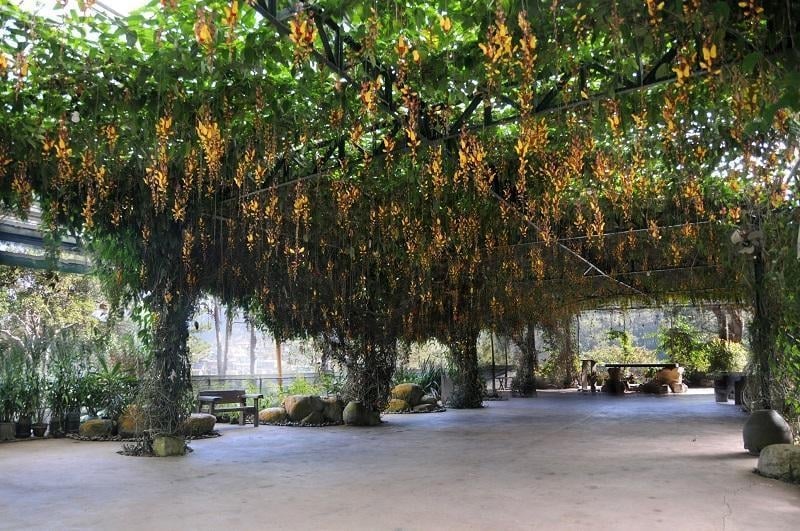
Winaca’s lush greenery | Image credit: Winaca Eco-Cultural Village and Forest Homes Official Facebook Page
You’ll find Winaca Eco-Cultural Village in the mountainous province of Benguet, where the air is always cool and crisp. The farm houses flora that thrive in the region, such as strawberries, Arabica coffee, flowering vines, and ferns used to colder weather. Here, you can also learn the ropes of growing food on land as well as through hydroponics.
When you’re done with your eco walk, opt for other leisure activities such as ziplining and fishing. Get your dose of cultural immersion by acquainting yourself with the Cordilleran peoples’ traditional huts. At Green House Cafe & Restaurant, grab the chance to taste the Igorot speciality, etag — meat that is dried and salted much like jerky.
Finally, stay a day or two in cottages made warm by a furnace on chilly nights. Your Winaca Eco-Cultural Village experience is topped off with a souvenir; take home a woven creation from Narda’s, the farm’s in-house weaving centre.
Address: Winaca Village, Caponga, Tublay, Benguet
Visiting hours: By reservation
Contact: Winaca Eco-Cultural Village official Facebook page
Travel time from Manila: It takes at least five hours and thirty minutes to drive to Winaca Eco-Cultural Village from Manila. If you’re coming from Baguio city, it will only be around 30 minutes by car, depending on traffic. Since you have the option to pass through Baguio, why not make an extended trip out of it?
How Baguio safeguards your health: With the national government’s COVID-19 protocols in place, you can rest easy knowing that Baguio is pretty safe! In fact, the World Health Organization (WHO) declared Baguio city’s efficient contact-tracing efforts as ideal models for COVID-19 management in the country. Baguio also developed a travel regulation system called Visitor Information and Travel Assistance (VIS.I.T.A.), which allows them to assist tourists and keep them safe all throughout their stay. The sooner travel resumes for international tourists, the sooner you can experience VIS.I.T.A. in Baguio city like a local!
Baguio is also part of the Reef and Ridge Corridor, a travel corridor that ensures safe passage for tourists thanks to unified COVID safety protocols across participating provinces. These are Baguio, La Union, Pangasinan, Ilocos Sur, and Ilocos Norte. Know more about it here.
7. Alameda Farm
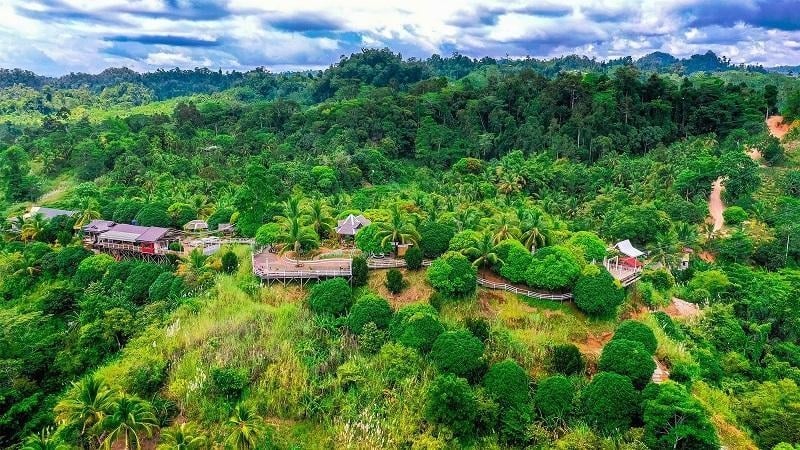
Image credit: Alameda Farm Official Facebook Page
Agriculture in the Philippines is fun and productive; Alameda is living proof. This farm in the Philippines’ Mindanao region stands as a government-accredited learning site that advocates sustainable agriculture and organic farming practices. It comes complete with a training hall for workshops and a souvenir shop where you can support small businesses and #LoveLocal.
What’s more, Alameda Farm brims with picture-perfect spots that will surely brighten your Instagram feed. Don’t miss the viewing deck that overlooks Surigao del Sur’s scenic Hamburger Hills. Game for more fun? Engage in adrenaline-pumping activities such as ATV riding, sky biking, and ziplining! We’d understand if a day isn’t enough to do all that; feel free to stay a couple of nights. Yes, Alameda Farm offers cosy accommodations, too!
Address: Hamburger Hills, Gata, San Agustin, Surigao del Sur
Visiting hours: By reservation
Contact: Alameda Farm official Facebook page
Travel time from Manila: Board a flight from Manila to Cagayan de Oro. This takes around an hour and 30 minutes. It will take you another two hours to drive to Alomah’s Place and Nature Farm.
8. BEMWA Farm, Davao
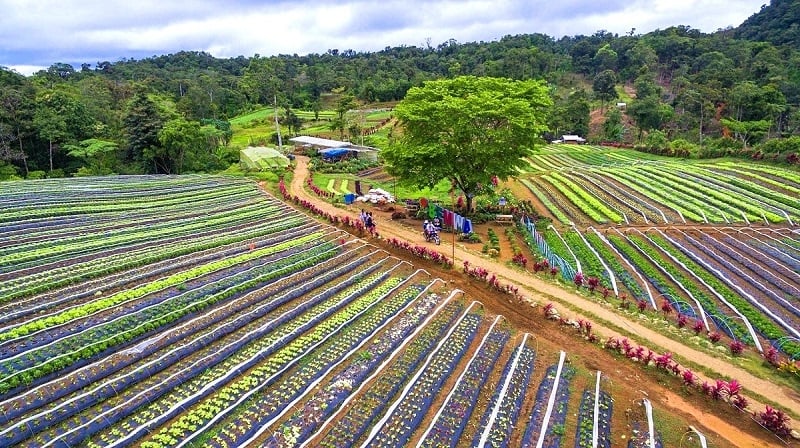
Take your cameras out because this farm in Marilog, Davao is totally Instagrammable. | Image credit: BEMWA FARM Official Facebook Page
Bet you didn’t expect to be greeted by a scene as Instagrammable as this! BEMWA Farm in Davao is known as a nature retreat where you can relax amid pine trees and neatly lined rows of leafy greens. Here, you can also purchase fresh produce and handmade products like strawberry jam and tablea (ground cacao beans) for making tsokolate (hot chocolate).
Address: Buda National Hwy, Marilog District, Davao City, Davao del Sur
Visiting hours: 7am to 5pm
Contact: BEMWA FARM official Facebook page
Travel time from Manila: Board a two-hour flight from Manila to Davao. From downtown Davao city, it takes around one and 30 minutes to drive to BEMWA Farm.
PHILIPPINE TRAVEL ADVISORIES HERE
9. Kenaniah Farm, Davao
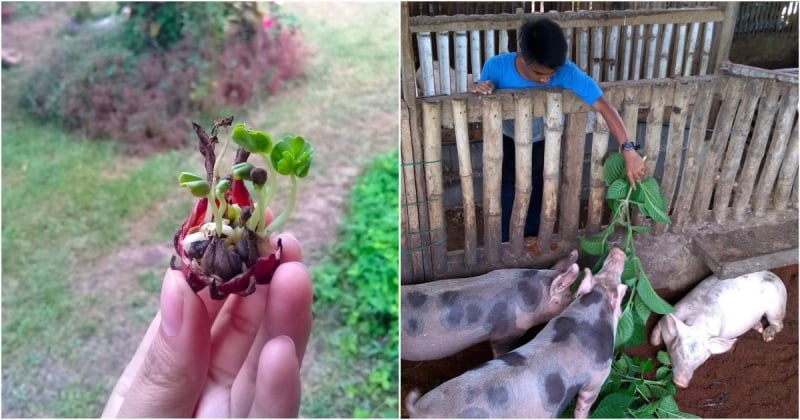
A peek into the farm nursery at Kenaniah in Davao. | Image credit: Kenaniah Farm Official Facebook Page
An agricultural cooperative, learning site, and tourist attraction, Kenaniah Farm in Davao shows how farm tourism in the Philippines can actually be developed to cater to various sectors. A hub for natural and organic farming, Keninah Farm roots itself in the principle that we are but shepherds of God’s creations. Here, you can easily “know the food source, protect the food source, support the food source” in just one visit.
Address: Purok 1A, Gumalang, Davao City
Visiting hours: By reservation
Contact: Kenaniah Farm official Facebook page
Travel time from Manila: Board a two-hour flight from Manila to Davao. From Francisco Bangoy International Airport in Davao City, it takes around one hour to drive to Kenaniah Farm.
10. Coffee Heritage House, Sagada
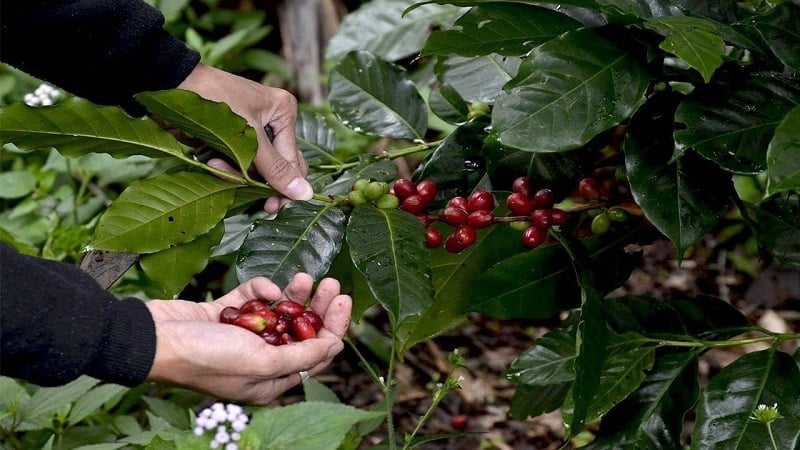
Image credit: Coffee Heritage House Official Facebook Page
Rejoice, lovers of the caffeinated brew! Coffee Heritage House offers cosy lodging and an unforgettable coffee farming experience in the heart of Mountain Province. In the Philippines, Arabica coffee beans grown and harvested in Sagada are a speciality. If you love your daily cuppa joe, this is where you can learn all about Philippine coffee — from bean to brew.
Address: Sitio Nadatngan, Brgy Madongo, Sagada, MT. Province
Visiting hours: By appointment
Contact: Coffee Heritage House official Facebook page
Travel time from Manila: Drive or hire a car to Sagada. From Manila, it takes around 10 hours to reach Coffee Heritage House. Here, you’ll also have the liberty to pass through Baguio for an exciting pitstop.
11. Costales Nature Farms, Laguna
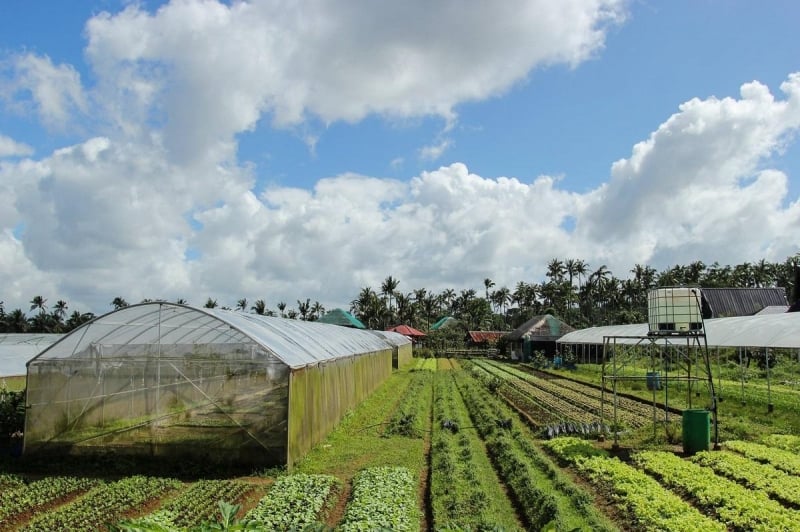
Image credit: Costales Nature Farms Official Facebook Page
There is a mountain in the CALABARZON region believed to be mystical. It is called Banahaw, and right at its lush foothills sits Costales Nature Farms, a popular organic farm and world-class farm tourism site dedicated to teaching visitors about the how-tos of sustainable farming. Choose from its many instructive farm immersions: a nature camp for kids, educational tours, and intensive workshops and seminars on farming techniques and best practices.
Out of all the model farms in the Philippines, Costales is one of the few that offers complete courses on how to put up your own farm. Why not learn a thing or two?
Address: Brgy. Gagalot, Majayjay, Laguna, Majayjay, Laguna
Visiting hours: 8am to 5pm
Contact: Costales Nature Farms official website
Travel time from Manila: It takes around four hours to drive to Costales Nature Farms from Manila.
12. Holy Carabao Holistic Farms, Laguna
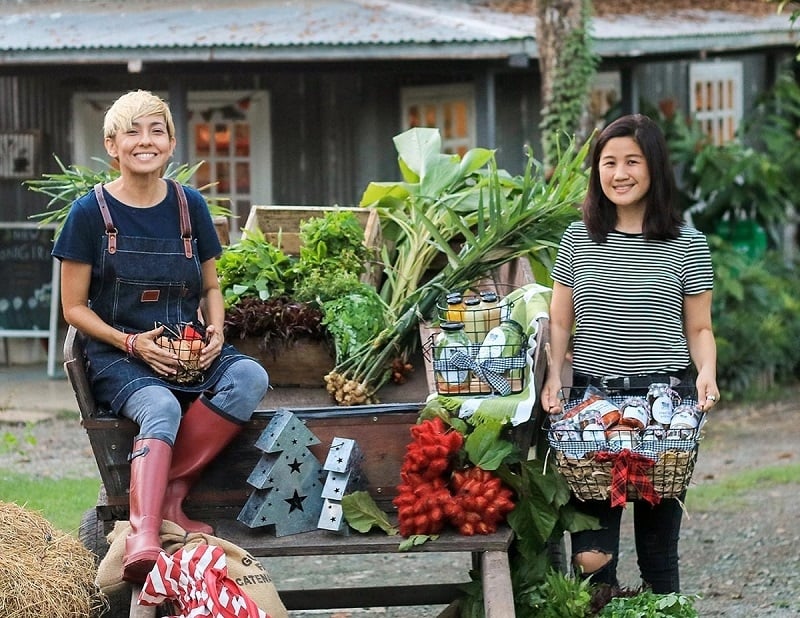
Holy Carabao Holistic Farms is one big family affair. | Image credit: Holy Carabao Holistic Farms Official Facebook Page
If there’s farm-to-table, for Holy Carabao Holistic Farms, there’s farm-to-family. It was, after all, founded by two innovative women who wanted their families to have healthier, more mindful lifestyles. That said, Holy Carabao is a holistic farm that takes to heart biodynamic, organic, and permaculture principles and practices. They’ll take you on educational tours and will even show you how to make your own compost!
Address: Sta. Rosa, Laguna. Further directions will be provided upon booking of tours.
Visiting hours: By reservation
Contact: Holy Carabao official website
Travel time from Manila: It takes around an hour and 30 minutes to drive to Holy Carabao Holistic Farms from Manila. This means you could easily flit back and forth from Metro Manila, especially with your own hired vehicle.
13. GK Enchanted Farm, Bulacan
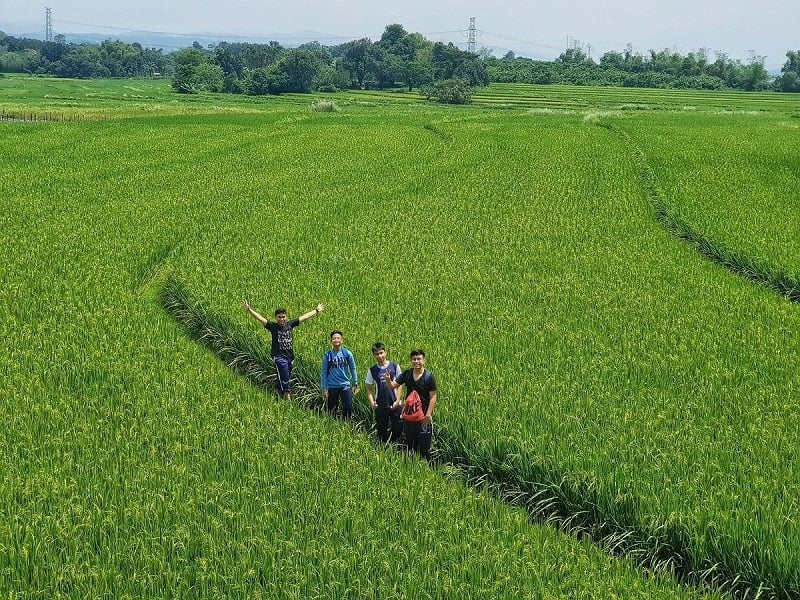
Image credit: GK Enchanted Farm Official Facebook Page
Gawad Kalinga (GK) is one of the pioneer groups that initially catapulted farm tourism in the Philippines into the red-hot status it enjoys today. The Gawad Kalinga Enchanted Farm is GK’s platform for “raising social entrepreneurs, helping local farmers, and creating wealth in the countryside”.
The farm tourism destination doesn’t only offer wonderful tours and farm immersions; it also serves as a training ground for those interested in making the world a better place through sustainable farming initiatives. Here, you’ll learn that farming is also a productive tool for community building.
Address: California St., Brgy. Encanto, Angat, Bulacan
Visiting hours: 8am to 5pm
Contact: Gawad Kalinga official website
Travel time from Manila: It takes around two hours to drive to Gawad Kalinga Enchanted Farm from Manila.
14. GarinFarm Pilgrimage Resort, Iloilo
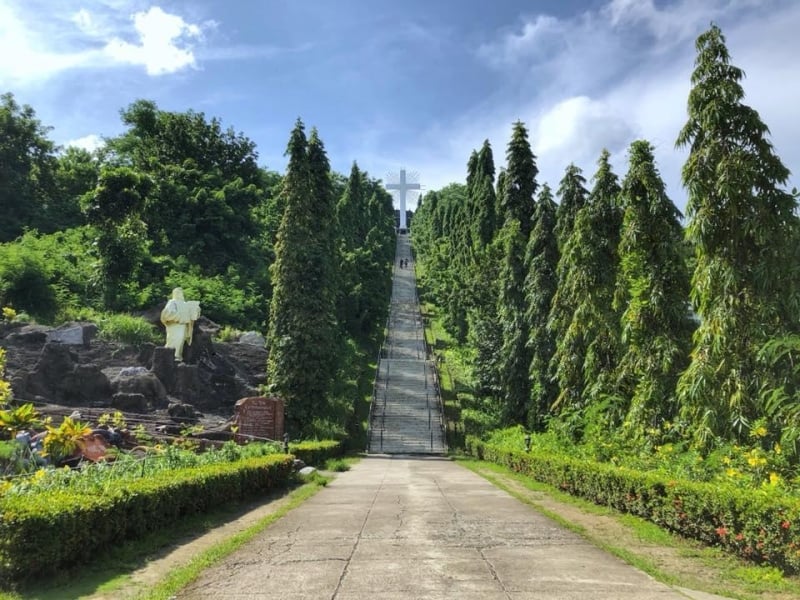
Image credit: GarinFarm Pilgrimage Resort
As you can see from its name alone, the GarinFarm Pilgrimage Resort is many things. It’s a tourist go-to, a rising pilgrimage site of sorts, and yes, it’s also one of the more popular farms in the Philippines!
While a chunk of the property is cropland, it also houses several tourist attractions. The most popular is called “Heaven on Earth”, an all-white feature that gives you a glimpse into what heaven might look like. It’s as pristine as medical frontliners would like our hands to be at all times; so don’t forget to observe impeccable hygiene during your travels, folks! Remember: You’re also responsible for keeping your immediate area clean and safe for the next visitors.
Address: Purok 2, San Joaquin, Iloilo
Visiting hours: 8am to 6pm
Contact: GarinFarm Pilgrimage Resort official Facebook page
Travel time from Manila: Fly from Manila to Iloilo; the flight should only be a little over an hour. From the airport, it takes approximately one hour and 30 minutes to drive to GarinFarm Pilgrimage Resort.
How Iloilo safeguards your health: Much like Davao, Iloilo City zeroes in on boosting COVID-19 management by establishing proper testing hubs. A COVID-19 testing station has been established at the Iloilo International Airport for travellers’ improved access to COVID-19 testing services.
15. Lucciole, Cavite
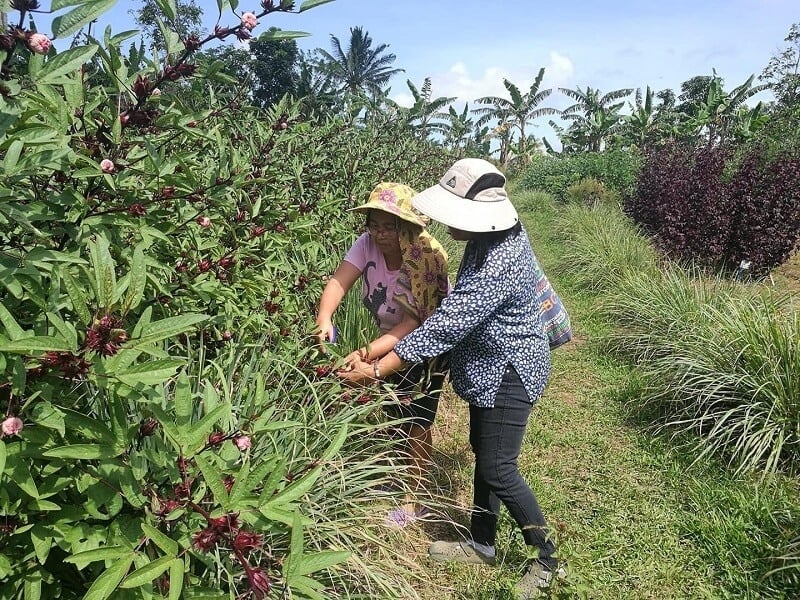
Image credit: Lucciole Official Facebook Page
Lucciole, a hilly property not far from Manila, is first and foremost a family farm. The folks who run it are proud to say that they practise what they preach: respecting their land’s original terrain.
An integrated, natural farm, Lucciole teaches visitors the basics of organic farming, such as companion planting and using herbal pesticide made from the Madre de Cacao tree. The cherry on top? The farm brightly comes alive at night thanks to resident fireflies! Whoever said that farms in the Philippines limit the fun to just daytime?
Address: Amadeo, Cavite. Further directions will be provided upon booking of tours.
Visiting hours: By reservation
Contact: Lucciole official Facebook page
Travel time from Manila: It takes around two hours to drive to Lucciole from Manila.
16. Mt. Kitanglad Agro-Eco Farm, Bukidnon
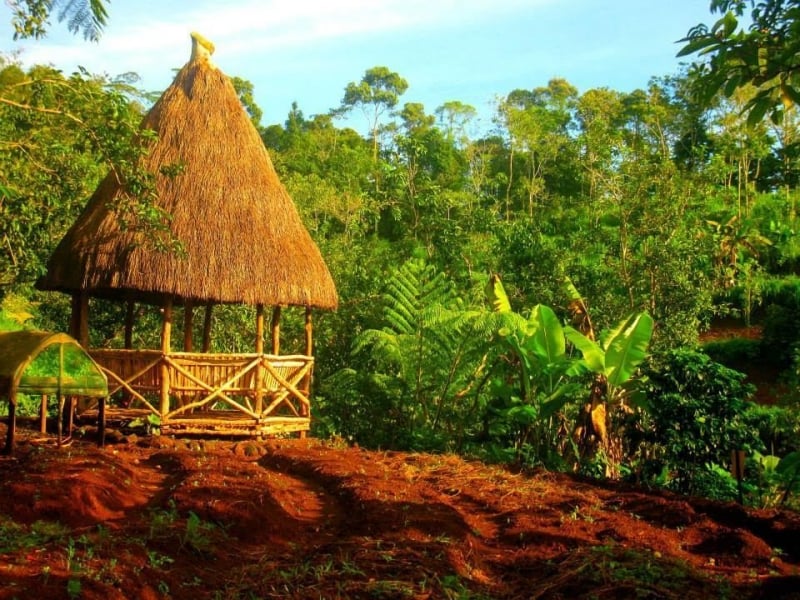
There’s plenty to see here! | Image credit: Mt. Kitanglad Agro-Eco Farm Official Facebook Page
Malaybalay in Bukidnon is an underrated gem in the Philippines. Adding to its many awe-inspiring features is Mt. Kitanglad Agro-Eco Farm. You’ll find the property near a massive land formation called Mt. Kitanglad, an inactive volcano known for the flavourful coffee beans it grows. Sip on this brew at Mt. Kitanglad Agro-Eco Farm, where you can also enjoy a farm tour, a forest trek, and a visit to its very own ‘Hobbiton’, among other activities — all for under S$2 (~₱70).
Address: Sinaburan, Imbayao, Malaybalay, Bukidnon
Visiting hours: By reservation
Contact: Mt. Kitanglad Agro-Eco Farm official Facebook page
Travel time from Manila: Board a flight from Manila to Cagayan de Oro. This takes around an hour and 30 minutes. From Cagayan de Oro, Malaybalay City in Bukidnon is two and a half hours away via land travel. It will take you another hour to drive to Mt. Kitanglad Agro-Eco Farm from the Malaybalay City centre.
How Bukidnon safeguards your health: The Philippines’ slow but sure tourism reopening assures the implementation of standardised COVID-19 protocols. All tourism spots in the country abide by measures set by the Inter-Agency Task Force for Emerging Infectious Diseases (IATF-EID) and DOT. That said, Bukidnon only allows tourist spots to accommodate 50% of their usual capacity. It will help to pre-book visits to every sight on your itinerary when your trip finally pushes through!
LATEST PHILIPPINE TRAVEL UPDATES
17. Vita Isola Leisure Farm, Bohol
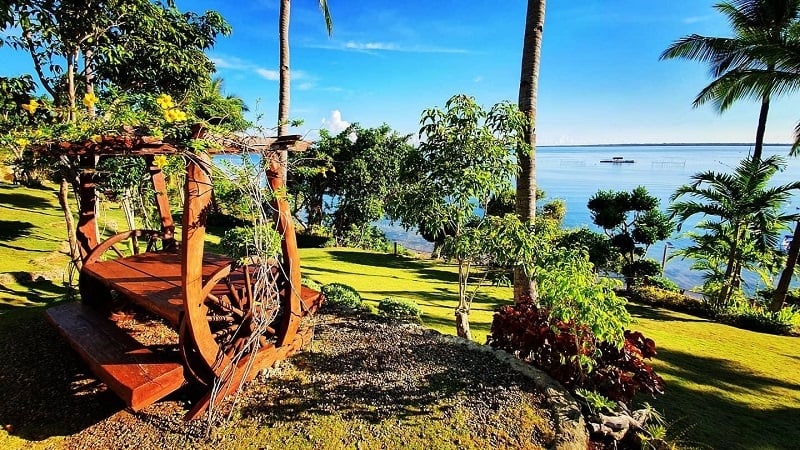
Vita Isola Leisure Farm, the epitome of island living. | Image credit: Visita Isola Official Facebook Page
Who says you have to choose between seaside fun and a farm immersion? At Bohol’s Vita Isola Leisure Farm, you certainly get the best of both worlds!
The property is located along the coastline of Sandingan Island in Loon. You’ll have plenty of access to the water for activities like mangrove tours, stand-up paddle boarding, and kayaking (take single kayaks for maximum social distancing!). Of course, there’s also the organic farm and animal pen, where you’ll learn more about sustainable farming free of harmful chemicals. What’s more, Vita Isola Leisure Farm features an aquaculture farm you can tour that’s just a quick boat ride away.
Address: Brgy. Ubojan, Sandingan, Loon, Bohol
Visiting hours: 8am to 5pm
Contact: Vista Isola official website
Travel time from Manila: Board a flight from Manila to Bohol. This takes around an hour and 30 minutes. From Bohol International Airport, the drive to Loon is a little over an hour, too.
How Bohol safeguards your health: Bohol reopens safely to the public with its very own seal of COVID-preparedness dubbed the “Ultimate Bohol Experience” or simply, UBE. Establishments that wish to operate in the new normal will have to secure the UBE seal, as part of the province’s way of kickstarting the Bohol Bubble — a travel bubble that allows for Bohol’s economic recovery through tourism. UBE seals will not only signify establishments’ COVID-readiness; they will also take into consideration sustainable features such as the use of renewable energy, improved sewage treatment, and limited carrying capacity. It’s nice to know that Bohol sees the new normal as an avenue to think past the pandemic!
18. Bayatakan Farm, Siargao
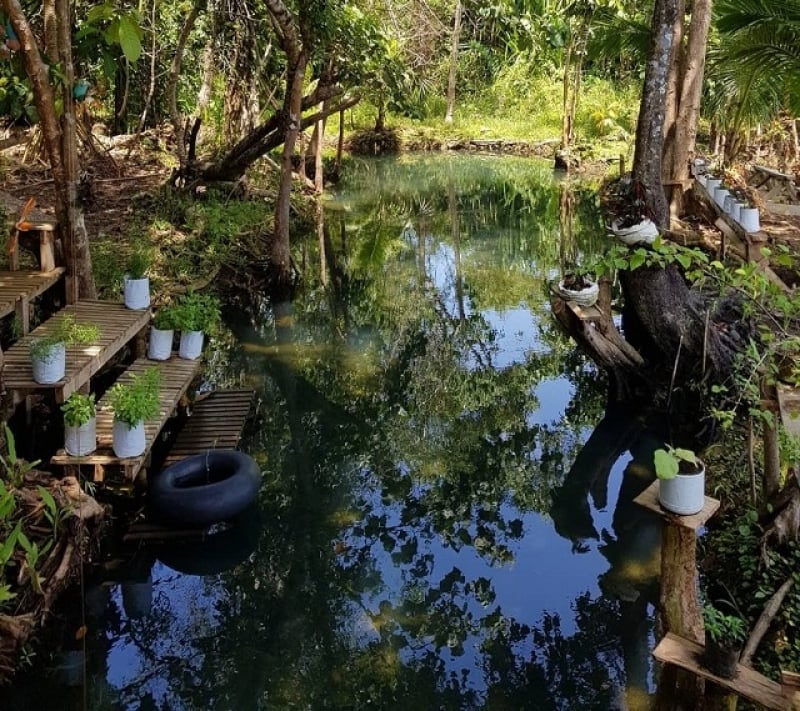
At Bayatakan Farm, you cap the day with a wholesome feast and quick dip by the stream. Ahhh, paradise! | Image credit: Bayatakan Farm Official Instagram Page
For some, ‘farm-to-table’ has become a buzzword of sorts; but Bayatakan Farm in Burgos, Siargao takes this label to heart. It was born out of the bayanihan spirit of a local nurse-turned-farmer and a Filipino-English entrepreneur who found it impossible to leave the island once he set foot on it. The idea was to support farmers in Siargao, all while giving travellers the chance to soak in a full learning immersion hinged on organic farming.
Siargao is a surfing capital, but it wouldn’t hurt to allot a day tour (or two!) to experience what it truly means to live off the earth.
Address: Brgy. Matin-ao, Burgos, Siargao, Surigao del Norte
Visiting hours: By reservation
Contact: Bayatakan Farm official Facebook page
Travel time from Manila: Board a Manila to Siargao flight, which lasts around an hour and 30 minutes. Usually, tourists stay in areas near General Luna for surfing; from Siargao Airport (also known as Sayak Airport) to General Luna, the drive takes an hour. From General Luna, you may again travel by land to Burgos; this takes roughly an hour and 30 minutes.
How Siargao safeguards your health: Siargao put up a Heals 911 Center for improved medical and health-related assistance. The island is also upgrading its water treatment and water supply systems, as well as regulating hygiene preparedness in all tourism spots.
19. Teraoka Family Farm, Pangasinan
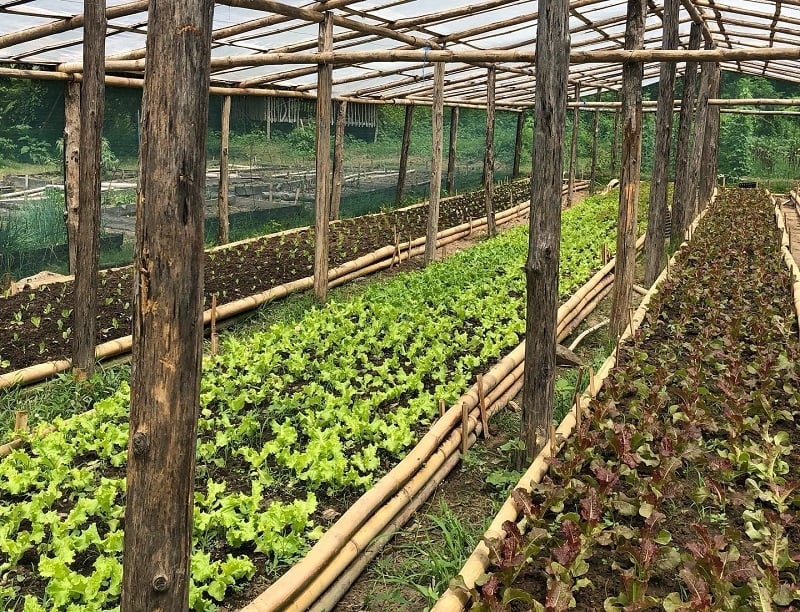
Image credit: Teraoka Family Farm Official Facebook Page
The owners of Teraoka Family Farm make sure they respect the land and its life force. Its entire 200 hectares are dedicated to growing “100% organic produce”, and with a single visit, tourists can learn what it takes to commit to a farmer’s lifestyle.
At Teraoka Family Farm, you’ll also get a glimpse of the owners’ own heritage: “Being a Filipino-Japanese family, we have heavy influence from both cultures. The resourcefulness of Filipinos and the detail-oriented Japanese which we apply to our business practices”.
Address: Brgy. Cabaluyan 2nd, Mangatarem, Pangasinan
Visiting hours: By reservation
Contact: Teraoka Family Farm official website
Travel time from Manila: It takes around three hours and 30 minutes to drive to Teraoka Family Farm from Manila.
20. Yamang Bukid Farm, Palawan
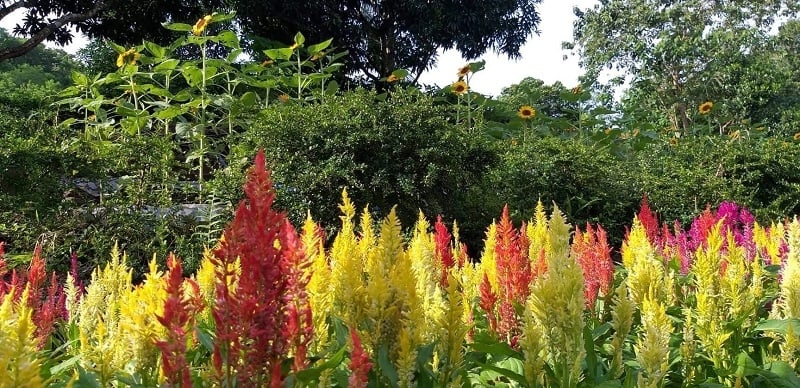
Don’t forget to take snaps of this Palawan farm’s Instagrammable landscaping! They even have designated toilets for the LGBT. | Image credit: Yamang Bukid Farm Palawan Official Facebook Page
As far as farms in the Philippines go, Yamang Bukid is an icon for all-natural supplements made from crops lovingly and painstakingly grown on their farmland in Palawan. I myself am a fan of their turmeric tea; their products make great souvenirs for easy packing and bringing home!
But beyond producing health-boosting tonics and brews, Yamang Bukid Farm also stands as a model ethical agricultural business and eco-tourism site. In fact, in 2019, it was part of the top four most visited tourism sites in Puerto Princesa — a feat considering that vacationers usually flock to Palawan for its beaches! Visit Yamang Bukid Farm and get a peek of the gargantuan effort that goes into running a full-scale agricultural business-slash-top farm destination.
Address: Brgy. Bacungan, Puerto Princesa, Palawan
Visiting hours: By reservation
Contact: Yamang Bukid Farm Palawan official Facebook page
Travel time from Manila: Board a Manila to Puerto Princesa flight, which lasts around one hour. Driving from the Puerto Princesa International Airport takes around the same time.
How Palawan safeguards your health: On top of the DOT’s COVID-19 protocols, a program called Resilient, Inclusive and Sustainable Tourism or TouRIST provides technical assistance for Palawan. These modules include the efficient implementation and operation of emergency health services in tourism sites. Moreover, Palawan promotes the responsible resumption of tourism in beloved tourist spots such as Coron, El Nido, and Culion with fuss-free travel bubble packages! Know more about Palawan travel bubble tour packages here.
LEARN MORE ABOUT COVID-19 SAFETY PROTOCOLS
21. Kahariam Farms, Batangas
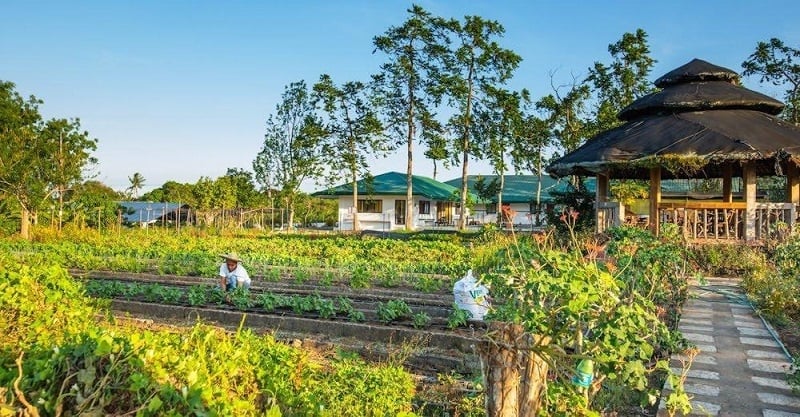
Did you know that Kahariam Farms also runs Urban Gardening Workshops? | Image credit: Kahariam Farms Official Facebook Page
If you’ll notice, most of these well-loved farms in the Philippines started out as family ventures. You could say the same for Kahariam Farms, a family-owned organic farm based in Lipa, Batangas. What makes them unique, though, is that they’re the largest earthworm farm in the country. This is why Kahariam Farms is considered an expert in gardening and soil conditioning; this rich learning experience is just among the things you’ll be taking home with you!
Sign up for a tour with Kahariam Farms to get you started on your zero waste journey. Their sustainable and organic farming techniques and technologies are sure to inspire!
Address: Lipa-Ibaan Road, Brgy. Adya, Lipa City, Batangas
Visiting hours: 7am to 4pm
Contact: Kahariam Farms official Facebook page
Travel time from Manila: It takes around two hours and 30 minutes to drive to Kahariam Farms from Manila.
22. Northern Blossom Flower Farm, Benguet
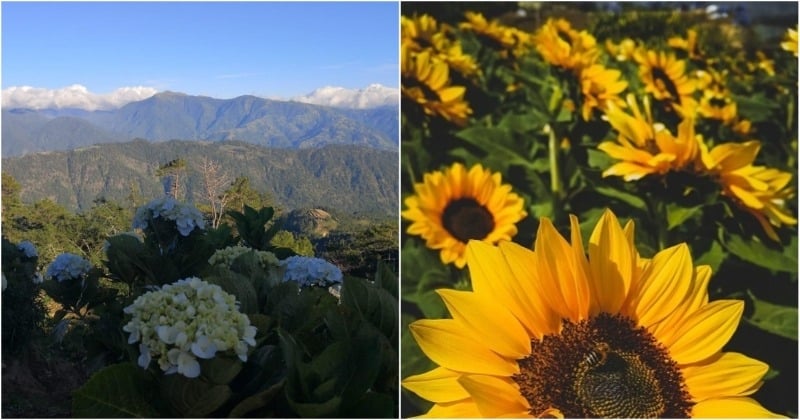
Image credit: Nothern Blossom Flower Farm Official Facebook Page (left), Kent Banes (right)
Nestled in mountainous and chilly Benguet is an expanse of land that adorns the terrain with flowers native to the Philippines’ colder regions. Northern Blossom Flower Farm absolutely makes for the most Instagram-worthy trip; but beyond this, you also get to know the different varieties of edible and decorative flora that flourish in the area. What’s more, it boasts of pine-covered forests, as well as breathtaking views of nearby mountains, Mt. Pulag and Mt. Timbak. It’s a farm tourism initiative that’s best seen during the blooming season from January to April!
Address: Brgy. Sayanagan, Atok, Benguet
Visiting hours: 6am to 5pm
Contact: Northern Blossom Flower Farm official Facebook page
Travel time from Manila: It will take around six hours to drive to Northern Blossom Flower Farm from Manila.
Big bonus: Banaue Rice Terraces, an agricultural marvel
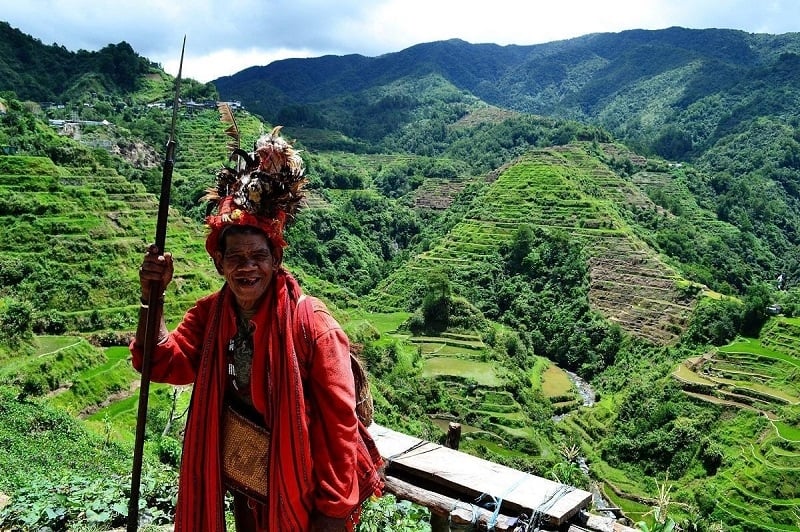
An Ifugao elder flashes a big smile for the camera. Behind him is the heritage of his people, the Banaue Rice Terraces. | Image credit: Edwin Juen Jr.
When you’re done planning your farm-hopping adventure, here’s another agri-destination you should check out while you’re in the Philippines. The Banaue Rice Terraces in Benguet isn’t a farm, but it’s an agricultural marvel to behold. These rice terraces were skillfully and quite artfully carved into the Cordillera mountains more than 2,000 years ago by the region’s indigenous people, the Ifugao. Stepping into this ancestral domain is indeed a magical experience, and you ought to know that it’s enlisted as a UNESCO World Heritage Site!
Also read: Get to Know the 6 UNESCO World Heritage Sites in the Philippines
Travelling opens our senses to the world’s beauty — and with farm tourism, we’re able to tap into a part of ourselves that is deeply rooted to this Earth we so eagerly roam. Plus, touring these farms in the Philippines may just be the nature-based therapy you need to chase those post-quarantine blues away. Why not go on an epic agri-adventure near Manila and beyond? Just remember, wash your hands, wear your masks and face shields, and keep your distance. We promise the fresh air will do you good!
PHILIPPINE TRAVEL ADVISORIES HERE
For more information, please visit app.philippines.travel, philippines.travel/safetrip, and DOT’s official Facebook page.
Brought to you by Department of Tourism – Philippines.






